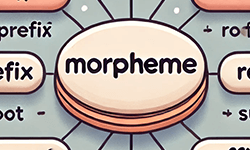
Language is a highly complex construct of letters and words. Today, we have no understanding about how it evolved to the speech we use today. However, just as etymology tells us about how words were formed from older languages like Latin or Greek, morphemes tell us about how our everyday language is composed of base words, affixes, and letters. The following article will cover everything you need to know about the formation of words and all the language rules you need to know.
Definition: Morpheme
Morphemes build the smallest units of language structure. The easiest example to depict this would be character-based languages like Japanese, where every word is composed of a few separate characters. It is not that different in the English language, as we too use small units of letters that form the base of every word and cannot be split into smaller ones that are still meaningful. They can be differentiated into roots (free morphemes) which can stand alone and bound morphemes, such as prefixes and suffixes, which are attached to the free ones.
The first sentence is composed of only free morphemes. The second one, however, includes a lot of them, such as suffixes modifying the tense of verbs as well as composed nouns like “staircase” and those using prefixes, such as “before.”
Types
Morphemes can be divided into two types, free and bound ones, depending on how and when they are used.
Free morpheme
Firstly, it is important to differentiate roots, or also called base words, from root words. A root word is a stem originating from another language, mostly Latin or Greek, which explains the origin and meaning of it. They also often belong into the category of prefixes. Roots, on the other hand, are the basis of each word, where affixes are then added.
However, take note that roots are not necessarily short, they are just units of language which cannot be split into smaller meaningful parts. For example, “Madagascar” does not split into “mad,” “gas,” and “car.” Neither does “calendar” split into “cal,” “end,” and “ar.”
Roots are always free morphemes because they can stand alone and still have meaning. Names of people or countries do also typically belong into this category. Furthermore, compound words are mostly built out of two or more free morphemes.
Bound morpheme
Bound morphemes, on the other hand, cannot stand alone. They are also referred to as affixes, which are moreover divided into the categories of prefixes and suffixes.
Undefined cases
Furthermore, there are cases, where people are still debating whether it is a free or bound morpheme because they can be used as a prefix or suffix as well as as free ones. Here are some examples:
Zero morpheme
A zero morpheme, or null morpheme, is an affix without a phonetic form. Generally, this concept can be neglected because it simply means that a form of the word does not differ from its root. Simple examples are words, where the plural does not differ from the singular, or the first-person singular of verbs, which does not differ from its root.
numerous advantages for Canadian students:
- ✓ 3D live preview of your configuration
- ✓ Free express delivery for every order
- ✓ High-quality bindings with individual embossing

Allomorphs
Allomorphs are variants of morphemes, mostly referring to bound ones. Variations happen when different affixes can be used to cause the same modification. An example can be forming the plural of nouns.
All of these turn singular words into plural but use different suffixes, which is why they are called allomorphs of the plural morpheme. Another example would be adverbs, where the allomorphs are “ly,” “lly,” or even “ishly.”
Phoneme vs. morpheme
Do not confuse morphemes with phonemes, though. While the former one is defined as the smallest units of speech, a phoneme refers to sound units. Phonemes are, in the English language, letters, but also their different pronunciation depending on the letters before and after. For example, the “O” in “our” is pronounced entirely different from the “O” in “octopus.” Occasionally, they overlap, such as in “I” or “A,” meaning words that consist of only one letter.
FAQs
Generally, there are two types of morphemes: free and bound ones. Free morphemes are roots, also called base words, which can easily stand alone without losing meaning. Bound ones are the opposite, they are affixes attached to the beginning or end of words to alternate their meaning.
While morphemes refer to base words of a language, phonemes are the basic sounds that compose these words. “Run,” for example, is a base word, which consists of the phonemes “R,” “u” and “n” in the exact way they are pronounced in this word. This is important to note because the “u” in “run” and the “u” in “ruin” are different phonemes.
Since morphemes are the smallest units of language, almost everything is one. If we decompose this first sentence, for example, we end up with the following:
- Roots: Since, morph, are, the, small, unit, of, language, most, is, one
- Prefix: al-
- Suffixes: -eme, -s, -est,
- Compound words: every, thing
Free morphemes are those which can stand alone, the smallest parts of language, meaning roots like “run,” “read,” or “grow,” as well as nouns like “hair,” and adjectives like “smart.”
Bound morphemes on the other hand cannot stand alone and are referred to as affixes. Examples for these would be “im-,” “un-,” or “en-,” as well as “-y,” “-ility,” or “-ing.”
